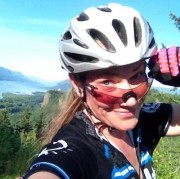Cycling Through Seasonal Affective Disorder
Monday, January 12, 2015

Burn off the shadows of seasonal affective disorder with light therapy, supplements and Vitamin Bike. Photo courtesy author.
Winter depression, also known as Seasonal Affective Disorder (SAD) is a syndrome of depressive episodes which affects more than 10 million Americans. Here in the Pacific Northwest the number of people suffering from SAD is highly concentrated, due to our heavy, dark cloud cover and long nights; in fact, several physicians and counselors I spoke to said they estimate about 60% of the local population suffers from seasonal depression. Even after we have transited the winter solstice and the days are growing longer, it will still be months before we get steady, adequate light which is the main antidote for SAD.
Many cyclists ride bikes year-round not only for transportation or fitness, but because they know exercise is powerful medicine; for many of us it is a natural anti-depressant. But what do you do on those days where the shadows are so deep and you're in such a funk that just taking the medicine feels impossible? Even if you know you’ll feel better, motivating to get suited up to brave the elements can be daunting.
To help neutralize the roller coaster ride of seasonal depression, there are a number of low-cost treatments which don’t involve antidepressant prescription drugs. Oregon Health Sciences University has a dedicated Sleep and Mood Disorders Laboratory which recommends—as front line defense and treatment of SAD—bright light therapy.
While each person requires different lengths of time for treatment, the general recommendation for light therapy is to use a high intensity light (10,000 lux), for about 20 minutes. Specialty lamps range in cost from $150 up. Jason Luoma, Ph.D., a psychologist at the Portland Psychotherapy Clinic, recommends avoiding cheap models which don’t produce enough intensity of light to be serious benefit.
Vitamin D deficiency is also rampant among Pacific Northwesterners. Dr Rachel Sterry, a naturopathic physician based in NE Portland, reports she sees an uptick in patients reporting depression in December, as the combination of wintry gloom and holiday stressors push people toward overwhelm and apathy. “Even strong athletes start to feel incapable of motivation to exercise, even though they know they’ll feel better, afterward,” said Sterry.
“Nearly every patient I have tested in late fall and winter for Vitamin D deficiency shows much lower than normal results. Vitamin D supplementation is a blanket therapy that benefits almost everyone I see,” Sterry continued. “In addition to light therapy, supplementation along with a proper diet is crucial to mood regulation.”
Sterry also advises balancing Omega fatty acids, and getting more Omega 3 fats from free range meat sources such as beef and buffalo; vegans will need more careful supplementation. In addition to supplementing with Vitamin D and fatty acids, she recommends eating more cooked than raw vegetables in winter, as digestion and metabolism are slower and cold foods are harder to digest.
Any or all of the above treatments should help alleviate the severity of seasonal depression—many report almost immediate benefit from even one therapy. Others see improvement in a couple of weeks.
If you worry that your depression is more severe and not only limited to foul weather months, see your doctor. But if you find yourself gaining weight, feeling cranky and tired, and having a hard time staying motivated to keep exercising since winter set in, it could be seasonal affective disorder at work.
Try burning away the shadows of SAD with these tips and once you’re feeling better, be sure to add back in the recommended daily allowance of Vitamin Bike, even if it’s just a simple trip to the store or commuting to work a couple of days a week. Even on cloudy, wet days, the fresh air and movement will do your body—and your mind and energy—good.





 Delivered Free Every
Delivered Free Every
Follow us on Pinterest Google + Facebook Twitter See It Read It